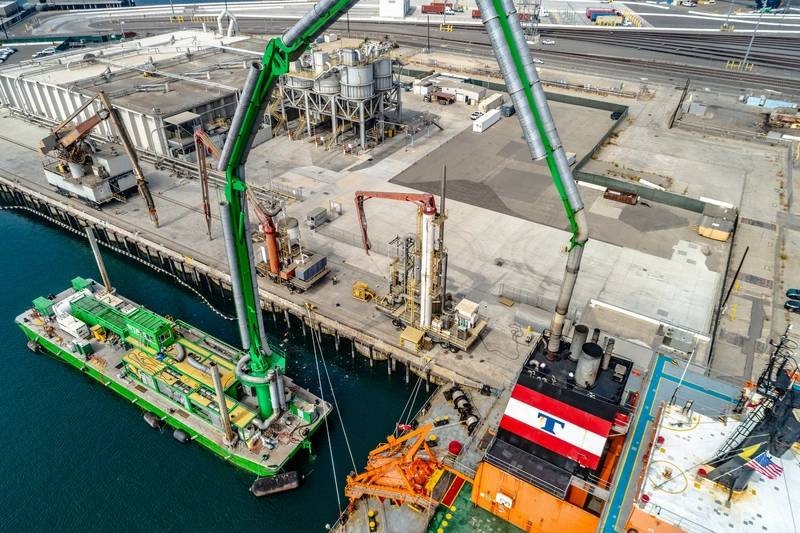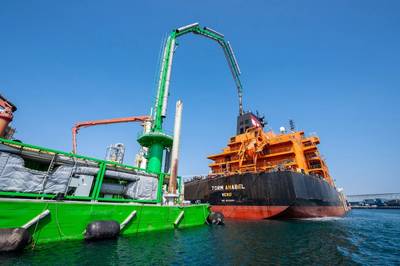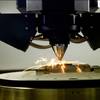Exhaust-sucking Barges Slash Ship Emissions in Port
STAX Engineering, based in Long Beach, California, has experienced significant growth since launching its innovative emissions capture and control technology earlier this year.
Available as a land- or barge-based solution, the company’s mobile, flexible exhaust capture system is designed to fit all ships without modification, removing 99% of particulate matter (PM) and 95% of nitrogen oxides (NOx) from all exhaust funneled into its system before the exhaust is released as purified gas.
The idea for the solution comes from seasoned inventor and engineer Bob Sharp, STAX Engineering founder and CTO. “He had the vision for a mobile emissions capture and control system that could modernize existing infrastructure for a cleaner future,” said Mike Walker, STAX Engineering CEO. “His technical expertise laid the foundation for the company’s core technology.”
Facing stricter emissions regulations and growing market pressure to reduce its environmental impact, the maritime industry has become a primary focus for Stax. California in particular presents a significant opportunity due to its regulations aimed at improving air quality and public health by minimizing pollution from docked ships. The California Air Resources Board (CARB) 2020 At-Berth Regulation mandates that oceangoing vessels at California ports reduce emissions by using shore power, emissions containment devices or cleaner fuels while at berth.
“We realized the industry couldn’t wait for long-term solutions like alternative fuels and infrastructure upgrades, which would take years and massive capital investment,” Walker said.
“Port communities worldwide face well-documented air quality challenges due to emissions from vessels at berth, which contribute to health concerns like respiratory issues and cardiovascular diseases. STAX offers a practical solution to this ongoing issue,” Walker explained.
 (Photo: STAX Engineering)
(Photo: STAX Engineering)
In addition to filtering out PM and NOx from vessel exhaust, Stax is actively expanding its system to include carbon capture, Walker said, noting that he anticipates rollout in 2025. “Once integrated, STAX will be able to trap and permanently store converted carbon dioxide, making any vessel using STAX services virtually emissions-free.”
For STAX, market acceptance has come relatively quickly, and Walker said momentum is building. “Since our launch, we’ve mobilized multiple barges along the California coast, with eight more in various production stages to meet the market's growing needs.”
“We’re looking forward to the arrival of our third STAX barge in the Port of Hueneme in late October 2024. Two more will be in service by the end of the year, and we’re on track to have 25 barges servicing the ports of California by the end of 2025,” Walker said.
“Our biggest challenge today is keeping up with the industry's demand for a solution like STAX. As regulations tighten and extend to more vessel types, we’ve seen a significant surge in demand. Managing our fleet of barges across U.S. ports has become an operational focus,” Walker said. “We’re hiring rapidly and growing fast to keep pace, building the team needed to help solve this emissions problem at scale.”
Today, STAX maintains a dedicated pier and production space in the Port of Long Beach, but the company aims to expand to other port sites. “As we grow, our approach to barge manufacturing will become even more region-specific. We aim to build STAX barges in the regions they will service, ensuring the most effective, efficient and sustainable production process wherever we expand globally.” Walker said.
 (Photo: STAX Engineering)
(Photo: STAX Engineering)
Barge operations
Depending on port preference, STAX barges can be moved by tugboats or using the company’s patented self-propelling technology—one of many innovations the company has developed, accounting for two of STAX’s 11 secured and pending patents, Walker said. “Once the vessel is positioned correctly, our team simply pulls up, raises the boom and begins the filtration process.”
Each barge measures 40 by 160 feet, and the boom, along with its pedestal, can extend up to 279 feet. “The system is designed to connect to all ship designs without modification, and with its flexible configurations, STAX can operate even in the most congested ports,” Walker said.
“Each barge operates with two crewmembers onboard at all times—a systems operator and a deckhand—who are responsible for placing the emissions collection device, monitoring and adjusting the system, and operating the spuds. The entire operation is connected online, allowing technology, engineering and maintenance teams to remotely manage the system’s health and performance.”
Walker said STAX barges adhere to regulations set by the CARB and Occupational Safety and Health Administration (OSHA). “We’ve secured multiple CARB Executive Orders (EO) to treat emissions from auxiliary engines on various vessel types, including containerships (EO G-23-294) and auto carriers/ro-ros (EO G24-054), and we’re in the final steps of securing an EO for tankers,” he said. “As we expand beyond California, we’ll continue collaborating with local authorities to ensure compliance with all necessary certifications and regulations.”














